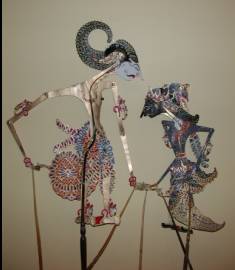

Date: Saturday, November 20, 2004
Time: 7:30-9:30 PM
Place: Auditorium of Bethesda Elementary School
7600 Arlington Road, Bethesda, MD
Admission: Free
Prince Rama and his wife Sinta have been living as exiles in Dandaka Forest for fourteen years. Giant Prince Rahwana, a member of a rival kingdom, sends his agent Kala Marica to abduct Sinta. Kala Marica arrives in the Forest disguised as a deer. Sinta is immediately enchanted with the lovely deer, and sends Rama to capture it for her. Rama leaves his brother Lesmana to protect Sinta in his absence.
Rama shoots the deer, but the deer starts to cry out in Rama’s voice. Sinta fears for Rama’s safety, and sends Lesmana off to assist him. He leaves her in a magic circle of protection.
With Sinta left alone, Rahwana makes his move. He disguises himself as an old man, uses his magical powers to destroy the protective circle, abducts Sinta, and flies with her back to his kingdom, Alangkadiraja. On the way, Rahwana and Sinta run into Jatayu, a Garuda (Eagle God) who has been charged with Rama and Sinta’s protection. Rahwana and Jatayu battle in mid-air, and Jatayu is mortally wounded. Before he dies, Jatayu informs Rama of Sinta’s abduction.
Rama enlists the aid of his friend Hanoman, the commander of
the mongkey army, and they set off for Rahwana’s castle,
Alengka. Rama wins Sinta’s freedom by killing Rahwana with
his magic arrow, Guwa Wijaya. At long last, Rama and Sinta
are allowed to return to their home kingdom of Ayudya.
Wayang Kulit - shadow-puppet theater - has been a signature of Indonesian culture since 907 AD. The stories derive from two classical Indian epics, the Ramayana and the Mahabharata, which came to Indonesia in the days of the Hindu kingdom, Airlangga. Like many other traditional art forms, wayang kulit experienced a sharp rise in popularity after Indonesia’s independence in 1945. A typical wayang lasts all night, from dusk until dawn. The setting is informal, with spectators coming and going at will, chatting, flirting, selling goods, and eating food. The wayang performed here is one of the best-loved and most popular stories with Indonesian audiences.
Dr. Joko Susilo is an eighth-generation dhalang, or Indonesian puppeteer. Dr. Susilo received his Ph.D. in music in 2000 from the University of Otago in New Zealand, on whose faculty he currently sits. Dr. Susilo has performed shadow-puppet theater in festivals and concert halls all over the world, from New Zealand to Europe to the Kennedy Center in Washington, DC. For the past year, Dr. Susilo has taught gamelan music and theory as a Fulbright Scholar-in-Residence at Bates College, ME.
A gamelan is an ensemble of tuned gongs, metallophones,
drums, and other instruments. Gamelan music can be majestic,
dynamic, or humorous. It is performed as concert music and
as accompaniment for dance and puppet theatre. The Central
Javanese Gamelan of the Indonesian Embassy is a diverse
group of community musicians from the DC metro area. The
group plays on Javanese instruments under the direction of
gamelan maestro Muryanto. The gamelan plays regularly for
Embassy functions, and has performed at the Kennedy Center
and the World Bank. Membership is open to the community.
If you are interested, please speak with one of us about
attending rehearsals.
Email: a@b.com, where "a" is actually my first name (jon, only 3 letters), and "b" is really joss
Phone: +1 240 604 4495.
Last modified: Tue Jan 1 03:13:29 EST 2008